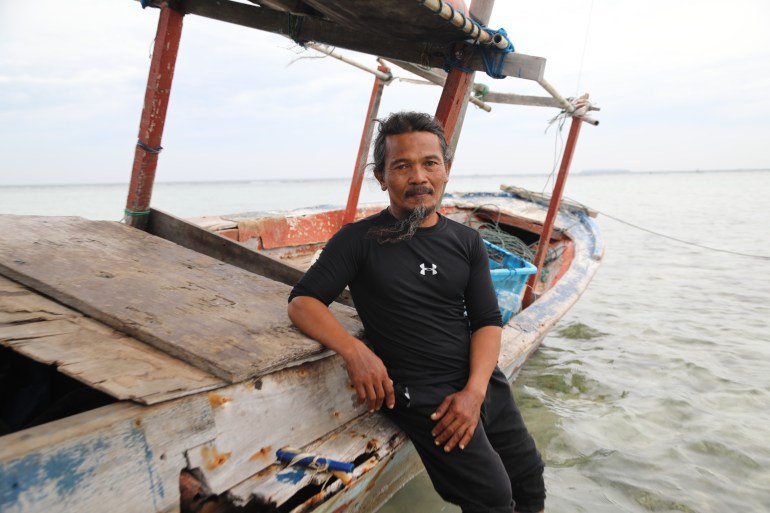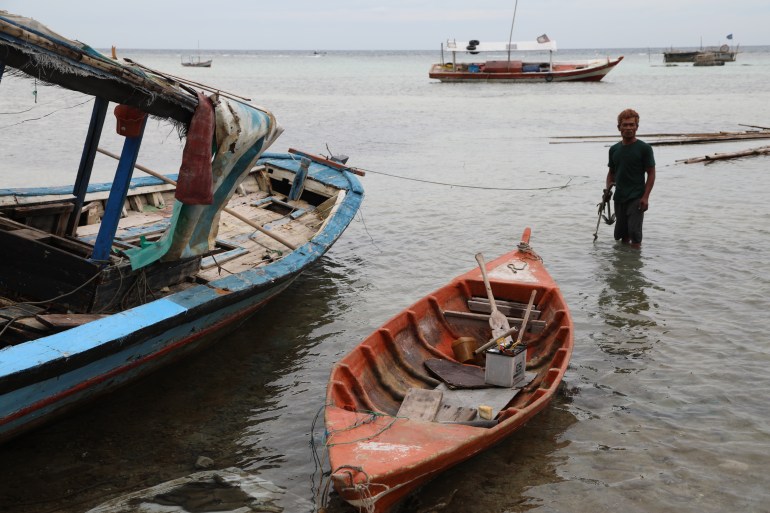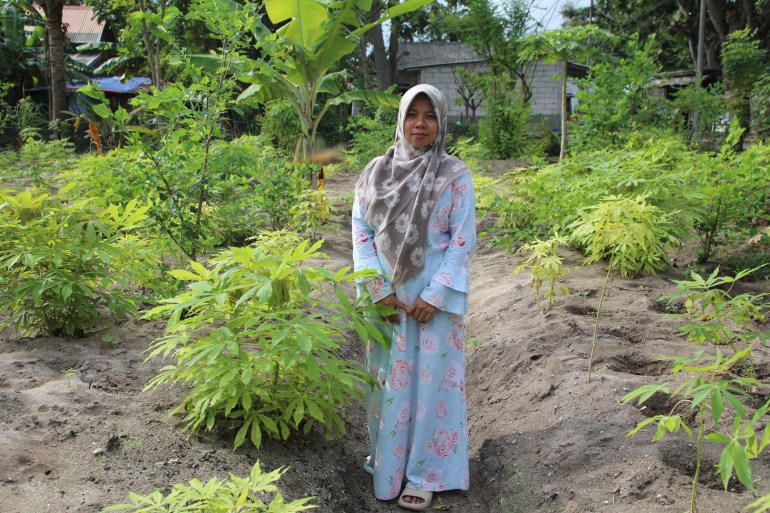Pari Island, Indonesia – When the primary tidal wave struck Pari Island again in 2018, Arif Pujianto’s whole residence was flooded for greater than 24 hours, contaminating the effectively from the place he sourced his ingesting water, rusting his bike and main timber panels to fall off the partitions.
The 51-year-old fisherman was pressured to desert his belongings and flee together with his spouse and son to the opposite facet of the Indonesian island, a part of the famed Thousand Islands that lie off Java’s northwestern coast, staying with a good friend in a single day.
“I used to be afraid,” Pujianto instructed Al Jazeera. “I turned a refugee alone land.”
The low-lying island of Pari, about 40km (25 miles) north of Jakarta, is on the entrance strains of the world’s local weather disaster. Excessive flooding is killing off timber and driving away vacationers; chaotic climate has devastated fishing hauls; and rising sea ranges are submerging the island of 1,500 residents.
On common, Pari lies about 1.5 metres (4.9 ft) above sea stage.
“I’m offended with the state of affairs,” says Pujianto, who now makes use of rainwater to desalinate his effectively. “I wish to defend my land. I take into consideration the way forward for my son, my household.”
On Wednesday, Pujianto and three different plaintiffs on Pari introduced that that they had formally lodged a lawsuit towards the Swiss-based cement producer Holcim for its alleged function within the local weather disaster. In July 2022, they submitted a request for conciliation in Zug, Switzerland – the place Holcim has its headquarters – however with no settlement reached, they’ve determined to sue the corporate within the Swiss civil court docket.
Supported by the Indonesian Discussion board for the Setting (WALHI), Swiss Church Assist (HEKS) and the European Heart for Constitutional and Human Rights, the plaintiffs are demanding that Holcim, the world’s largest producer of constructing supplies, scale back its carbon dioxide emissions by 43 % by 2030.
They’re additionally demanding the corporate co-finance adaptation measures on Pari resembling mangrove plantations and, considerably, that it pays “loss and harm” for its function within the local weather disaster.
In accordance with a HEKS-commissioned examine by the Local weather Accountability Institute in america, Holcim emitted greater than 7 billion tonnes of carbon dioxide between 1950 and 2021 – the equal of 0.42 % of all international industrial emissions in human historical past.
The Pari claimants are searching for a complete of 14,700 Swiss francs ($16,000), about $4,000 every, which has been calculated as proportional to Holcim’s contribution to general local weather harm.
“Holcim has been conscious of the excessive emissions created by cement manufacturing and its impacts on the local weather for not less than 30 years,” says Lorenz Kummer, a campaigner at HEKS. “Nonetheless, over that point, the corporate greater than doubled its emissions and people damaging results are being felt by the individuals of Pari.”
A spokesperson for Holcim stated in an announcement that local weather motion was a “high precedence” for the corporate and that it was “taking particular person motion and supporting international multilateral frameworks for collective impression to be a part of the answer.”
The assertion added: “We don’t imagine that court docket circumstances targeted on single firms are an efficient mechanism to deal with the worldwide complexity of local weather motion.”

The Pari islanders’ case towards Holcim, one of many first to be initiated by affected events from the International South, is a part of a rising motion for “loss and harm” and may very well be the catalyst for extra local weather litigation.
The case marks the primary time a Swiss firm is being held accountable within the courts for its function in local weather change.
“This type of litigation reveals that policymakers aren’t doing sufficient to deal with the wants of the individuals impacted,” says Noah Walker-Crawford, a researcher specialising in local weather litigation at College Faculty London.
“If the claimants have been to win, it might set a large precedent. It could make these accountable for the harm pay.”
‘International justice’
Campaigners argue it’s a matter of “international justice” that folks dwelling largely in creating international locations obtain compensation as they’ve been disproportionately affected by climate-related damages and losses – by flooding, warmth waves, storms, droughts and extra – largely attributable to industrialised international locations and international companies.
In accordance with an evaluation in July, the US has since 1990 inflicted greater than $1.9 trillion in damages to different, largely poor, international locations on account of its greenhouse fuel emissions – by heatwaves, crop failures and different penalties.
On the United Nations Local weather Change Convention (COP27) in November, European leaders acknowledged their function within the local weather disaster and agreed to arrange a “loss and harm” fund to assist essentially the most weak however no concrete funding has but been established, nor a mechanism by which the funds could be dispersed.


A number of authorized challenges have been introduced over local weather as time runs out for at-risk communities.
A Peruvian farmer and mountain information are taking motion towards the German vitality agency RWE, whose case is ongoing, whereas Pals of the Earth Netherlands gained a landmark court docket ruling in 2021 that ordered oil big Shell to cut back its carbon dioxide emissions by 45 % in 10 years.
In accordance with the newest report by the Intergovernmental Panel on Local weather Change (IPCC), dangers attributable to sea stage rise together with erosion, flooding and salinisation are anticipated to “considerably improve” by 2100 alongside all low-lying coasts.
Information from Indonesia’s Nationwide Catastrophe Mitigation Company reveals that in 2021, there have been 5,402 disasters, together with 1,794 floods – up from the three,814 disasters and 784 floods in 2019.
Yonvitner, a professor of fisheries and marine science at Indonesia’s IPB College, warns that if emissions proceed on their present trajectory, “catastrophe” will strike the archipelago’s 17,000 islands and the 150 million individuals who dwell close to the ocean.
“This can be a gravely critical difficulty,” he instructed Al Jazeera. “Not solely Pari however all throughout the nation’s coastal space, there’s a important affect of the local weather disaster.”
‘Not regular’
WALHI and HEKS say 11 % of Pari island has already been submerged during the last decade and that by 2050, most of it will likely be underwater.
“Indonesia is the most important archipelagic state on the planet,” stated Parid Ridwanuddin, officer for coastal, marine and small islands for WALHI. “If we proceed on the identical trajectory, sooner or later, many islands will disappear. Pari is in critical hazard.”

The inhabitants of Pari, which earlier than the COVID-19 pandemic welcomed greater than 1,000 vacationers each month to its idyllic seashores, dwell naturally low-carbon lives, actively defending corals and mangroves. Coconuts, bananas and papaya all develop on the island, and the mangroves teem with fish, crabs and even crocodiles.
“We’re near nature right here,” stated Bobi, a 50-year-old fisherman who is among the islanders concerned within the case. “I cry after I think about the longer term. Many homes will probably be destroyed. No one will have the ability to dwell right here.”
“Industries mustn’t solely earn cash and extract assets, they’ve to think about sustainability as a result of we solely have one planet, no different,” he added.
Suleiman, the island’s group chief, says tidal floods that beforehand occurred as soon as each 5 years now strike the island a number of occasions yearly, with three such floods occurring in 2022. Two boats, he says, sank at sea throughout tough climate.
“Climate modifications are regular, they’re a part of the season,” he stated. “However when issues turned extra critical, when homes have been destroyed, I realised this isn’t regular.”
Asmania, who can also be concerned within the Pari litigation, says revenue for her guesthouse has halved since large-scale flooding on the island started.
“After the tidal waves hit the island, many vacationers cancelled their reservations,” the 40-year-old stated.
Asmania, who like many Indonesians has just one identify, says the intense climate destroyed her seaweed farm so she and a number of other different ladies have been pressured to develop crops on Pari, which is simply 2.6km (1.6 miles) lengthy and 430 metres (0.27 miles) at its widest level.

Edi Mulyono, one other claimant and the sixth technology of his household on the island, has been a fisherman for 3 a long time. He says that when beforehand he may catch in extra of 100kg (220 kilos), he’s now fortunate to return with 20kg (44 kilos).
Because the solar begins to rise above the rows of coconut timber and clear blue waters alongside Pari, Mulyono is making ready his battered picket boat for an additional day at sea.
“I may predict the climate earlier than,” he stated. “Throughout the 12 months of the 12 months, there have been seasons for various sorts of fish, like tuna and squid. However now it’s develop into chaotic. The Earth is getting previous. It’s in disaster.”

